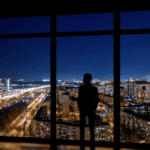In a world where maintaining a competitive edge comes down to a company’s ability to attract and retain talent, leading executives and real estate teams are scrambling to meet the rising expectations of the modern workforce.
The struggle is as real as the battle for talent is fierce: how do you turn your real estate portfolio into a place that employees want to come to every day? How do you create space to foster collaboration? Employee productivity? How do you ensure your brand and your standards for the employee experience are consistently represented across a growing global portfolio? How do you leverage the latest technology to drive a culture of innovation?
But most importantly, how do you do any of this while delivering against financial KPIs?
Stuck between delivering a superior employee experience and minimizing operational costs, leading Fortune 500 companies are investing in a new category of technology designed to address these often competing priorities: the workplace experience app. By putting technology directly into the hands of their workforce, real estate leaders can deliver the real-time, on-demand control that their employees expect, while simultaneously getting more out of their existing systems to drive operational results.
Let’s take a look at the unique dual benefits of the workplace experience app.
A superior—and empowered—employee experience
First, let’s take a step back and consider the modern worker. There have been many studies around the rise of millennials in the workforce, but the modern worker, in actuality, spans across generations. And they expect a lot more from their workplace: more choice, more control, and more flexibility about how, where, and when they work. Employees’ complaints around not having enough space, not having (or not being able to find) the right space, or simply being uncomfortable in said space simply represent an employee productivity drain that ultimately costs companies.
Workplace experience apps aim to bridge the gap between these rising expectations of employees and the physical workplace itself. Comfy, in particular, is the only solution that intelligently connects employees and their workplace in real-time to create amazing experiences. By integrating with physical and digital workplace systems, Comfy feeds contextualized, real-time information and control to employees. By empowering the workforce directly, Comfy helps employees better navigate their workplace and connect directly to the resources, people, and spaces they need to be most productive.
This type of employee-workplace connection is quite rare, even for the most innovative companies. As an example, consider the common pitfalls of rolling out agile workplace initiatives. One of our clients, a major Silicon Valley tech leader, was forced to roll back its free address program after its unexpected backfire; without a tool to help employees find the space they needed amidst the changing workplace arrangement, employees simply opted not to come into the office at all. For the real estate executives concerned about low space utilization, the results were a flop.
It’s the connection between the physical workplace and the employees—through contextualized information and control—that truly drives a superior workplace experience.
Today with Comfy, the company’s employees are armed with the ability to find and book the desks or workspaces they need—even those categorized as “recently occupied,” based on real-time occupancy sensor data. Employees can make desk selections with the extra context of knowing which amenities and rooms may be nearby, and can adjust temperature and lighting to their own personal preference in their space. By leveraging information from all existing workplace systems, Comfy creates a real-time, personalized experience that employees love, and that ultimately increases their overall productivity.
Many workplace apps claim to drive employee engagement and satisfaction. But ultimately, it’s the connection between the physical workplace and the employees—through contextualized information and control—that truly drives a superior workplace experience. In turn, this also generates feedback: actionable insights about how, when, and why employees are using different resources around the office, to help real estate professionals truly optimize the space.
Which brings us to the second key point of value for the workplace experience app…
A new level of workplace intelligence—to drive operational results
Historically, buildings and the people inside them had no way to talk to each other. They each operated in their own silo, with various hardware/software solutions installed to “optimize” the operation of the building, and separate people-focused initiatives designed to make employees productive and comfortable “enough.”
Today, IoT-enabled solutions like workplace experience apps are disrupting the traditional, silo-ed relationship between people and their buildings. And whether real estate leaders realize it or not, they’re finding themselves managing what’s starting to feel like a workplace tech stack.
Workplace experience apps like Comfy give real estate executives a straightforward, streamlined solution: one single technology investment to help deliver a superior employee experience AND operational savings. It doesn’t matter what existing systems or infrastructure a building has already in place—the beauty of Comfy is that is seamlessly integrates into any building management system, any workplace system (calendars, IWMS, etc), and integrates with any type of existing workplace tech (occupancy sensors, lighting controls, etc).
Together, workplace apps, building systems, and workplace tech like sensors work together to compound the value and intelligence they each deliver on their own. As an example, companies that struggle with low space utilization often have many rooms that are “booked” but remain unused—which can be known from looking at sensor data. But because workplace apps like Comfy integrate directly with digital and physical tech, they can read and react to occupancy data (is anyone actually in the room?) and calendar data (is the room booked?), and actually “free” up spaces in real-time, driving higher utilization of existing space (up to a 30% increase) and helping employees find the resources they need, right when they need it.
If the concept of a workplace tech stack isn’t quite a thing yet, it will be—and workplace apps like Comfy (that plug right into the systems and tech you already have) ensure that the value you get from your investments today simply increase over time.
With today’s real estate costs on the rise, office space under-utilized, and employee expectations rising, the value of this type of workplace intelligence combined with real-time control is huge. And as more and more companies move towards agile workplaces and flexible work arrangements, the market for better, smarter tools to help employees navigate these changes will continue to boom. But only the new category of workplace experience apps has proven to simultaneously fuel both operational results and employee engagement, productivity, and satisfaction. It’s a unique, dual value proposition that the savvy real estate executive can’t afford to ignore.
If you’d like to explore how Comfy’s workplace experience app can drive value for your organization, chat with us today.



